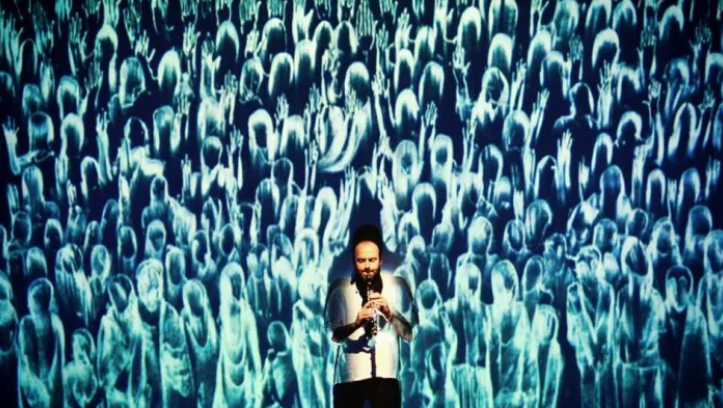Home Within: Imagining Syria’s Future
Reflections on the 2022 performance of Home Within in Mexico City
Middle East & North Africa Lead at the International Resource for Impact and Storytelling (under a partnership with Mimeta)
“When the lights were turned on to the tune of endless clapping by the audience, I realized that I had not been alone in this transformative journey.”
In 2011, I had been forced out of Syria at the height of the crackdown on its peaceful revolution. I have yet to visit the country again, and may never be able to return to my home there.
As I watch the news of the earthquake that re-shook Syria and devastated Turkey, I feel an urge to reinsert myself in the energy of the performance of Home Within. That was a remarkable moment I first experienced in October 2022 at the Centro Cultural del Bosque in Mexico City. The work of Syrian composer and clarinetist Kinan Azmeh and Syrian-Armenian visual artist Kevork Mourad, the piece is a 60-minute audio-visual performance documenting specific moments in Syria’s recent history. As I was watching Home Within, the past twelve years of my personal history and that of the Arab region I belong to rolled out in front of my eyes, touching all my senses, shaking me with pain, then uplifting me with hope.
Kinan Azmeh during the performance. Image credit: kinanazmeh.com.
The clarinet accompanies live visual sketching of the people, squares, cities, streets, homes and dreams that have shaped the Arab Spring protests, their suppression and the destruction and displacement that followed thereafter. Azmeh’s clarinet breathed life into Mourad’s live sketching projected on the screen and in my soul. Together, they traced the moments of high aspirations and utter despair.
Their imagination and hopes for the future made this experience truly transformational. We at the International Resource for Impact and Storytelling are on a permanent quest for what we call “hopeful futurism.” It’s a rare find, even in our world of philanthropy, abounding with all kinds of stories.
Azmeh and Mourad showed us that a different ending is possible, visible and tangible. They opened up horizons of possibilities out of the despair brought by the destruction and the displacement that we all experienced after the crackdown on the Arab Spring. The very destruction Syria is witnessing again today, in the aftermath of an earthquake that followed a decade of war on its people. Suddenly, they took me back to Damascus. They removed the bodies from underneath the rubble, re-erected destroyed buildings and washed the blood off the trees and benches. They rebuilt the city, cleaned up the squares and liberated the prisoners from their cells. Home was more beautiful than it had ever been. Suddenly, the dream of change became possible again.
Image credit: Pinkfish.
By the end of the performance, I was in a trance. When the lights were turned on to the tune of endless clapping by the audience, I realized that I had not been alone in this transformative journey. Audiences from all over the world had been equally moved by the experience. It may have touched a different place in their memory than mine, but it still ignited the same sense of pain, hope and agency.
Looking back at the performance, I realize that the time travel I experienced was equally as important as the way it opened up the future for me and for many others like me. In a way, Home Within condensed in 60 minutes everything I have dedicated myself to in the last 25 years of my work in support of arts, culture and social change.
Like a big cloud bringing the promise of rain on a dry land, this performance brought together everything to demonstrate the power of creative storytelling in the impact narrative field: all the strategies, the projects, the budget meetings, the evaluations, the artists, their organizations, hubs and networks.
This collective transformative moment would not have been possible without the talent, imagination and mastership of the artists who created this show. But the logistics are equally important, as moments like this aren’t possible without selection committees, festival organizers and funders, communication and publicity people, and all the people who secured the venues, the partnerships, the media coverage. These individuals work in partnership–and for or sometimes despite institutions–with the artists in turning creative imagination into social power.
The performance of Home Within was part of the Requiem for Justice Festival powered by Landscapes of Hope, a community of 22 civil society organizations from around the globe and across sectors, gathered by their belief in the need to bring about effective social change in situations of distress. Requiem for Justice is an attempt by this network to manifest the role that art plays to protest against injustice, to reflect upon and analyze human shortcomings in the face of today’s challenges and to imagine a better future.
Tribute to earthquake victims by the Syrian artist Haitham Sayegh
The four-day rally in Mexico City in October 2022 brought together around 60 artists, poets, novelists, academics and activists from over 15 countries to take part in public event discussions, concerts, theater performances, talks, exhibitions, film screenings, poetry recitals, and even a cooking show. Landscape of Hope is an initiative of Action for Hope, an IRIS and MIMETA grantee partner, pioneering exceptional work on the crosslines between creative expression and the social, cultural and psychological needs of distressed and displaced communities.
It’s only been a few months since I experienced Home Within, and now the world’s attention is once again turned to Turkey and Syria, where tens of thousands have died in the terrible earthquake a month ago. Artists are rallying in support of the devastated communities. Throughout this year, you’ll have a chance to experience Kinan Azmeh’s music at benefit shows for the relief efforts. You can see a schedule of Azmeh’s upcoming gigs in Europe and North America here, and follow Kevork Mourad’s gallery work on his website.





